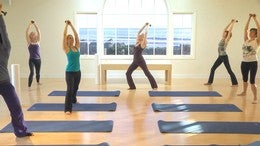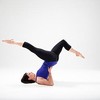Description
About This Video
Transcript
Read Full Transcript
So welcome to the class and um, it's about federal toning and the healthy back and mainly also the three layers of the lumbar Fascia and the little bit of Tomi toning of arms, leg and trunk. So great that you're here. So we started in that position actually. Yeah. And maybe you want it to sit a little bit at the back end of your mat. That will be really great. Exactly. So walk yourself into the folic position here and I'm just very, very easy.
You can actually use also play place your feet and the toes and push them a little bit into the Madden into the ground. And then you just start a little bit of a swaying coming from back to front and into your bag and your sit bones elongating the sky Ellen gating. So you get a nice sprit through your spine. Exactly. That's just to get a little bit about body going. And also you also find yourself venue.
Bring your just over your hands that you push back was a little bit of a push into the ground so that you have a little bit of an elastic kind of a more moment here. Okay, great. So next time you're back, stay back. And then we rise with a round back to have a nice spreading lumber festival sheet there. And you bring yourself back the chest between your hands and the abos facing towards your thigh and in really push yourself up round in. Nice. Especially in the lower backside. Move forward. Stretch the back, open the chest, get back up again. Right. And really enjoy that movement. It's preparing you.
So getting you going a little bit right up. Push back next time and you're just moving from and sliding back throughout and the crass the fluid and get onto your right side. Get back into them sender, move up, get on your left side. Okay, great. Here we are. So now you're staying and you're being a little bit more liberal.
Warmed up already. So now you're pressing the toes into the mat and you also have a really nice push down off your hands and you elevate the tip of your skull and just lifting a little bit the knees. Now we're getting the cord a little bit growing. Bring yourself back and also get the shoulders in health, the shoulders in place, right? Just do it just three or four or five times. Keep you in the gap.
Bring the leg back and now you're in touch with that knee. The forehead. It's a little bit to get already the second layer after the lumber dorsal fresher going. What? Bring yourself back. Push back, rise up, round your back. Push back and really enjoy that little spirit, especially on a lumber door to fresh and bring that chest onto and between your hands. Really close to the ground. Spread through.
Yeah, find your rhythm. Okay, next time getting up and 12 fourth we start again. Put a little bit up there. Get down. So do your shoulders. Long skull, stay up. Bring the other leg back. Sadly, that's the other one with me. And then your four hurt Anthony, bringing them took ever get back into the plank position.
Walk on the spot here, which up until the up stretch and now you just release the hands a little bit. So you're pushed lower your arms really backwards. You melt throughout your chest on the [inaudible] and the thoracic spine. Keeping an eye on a little bit of a bounce there to just mobilize the vertebra is a little bit to actually really enjoy that little bouncing. And then you'd very, very slowly start with just walking on the spot and you walk on the spot.
And also the sit bones are engaged. Yup. You go cool. And then you start just increasing a little bit of rhythm and speed. You walk on the spot and then you just start a little bit like running on the spot. Yep. And then you just change the little jumps and then kind of changing position and you jump till you get in that squatted position.
Yeah. Cool. Bring your hands on your knees. Now the first thing is we stretched below aback. Yeah. And then we roll and tilt the pelvis. So we getting a nice spread through the first layer after your lumber daughter fresher. What's up, watch out that you're not slumping in the upper body. So we have a nice Brit here.
Really getting long from the tip till the sit bones and then you roll the pelvis into until did a little bit, you could easily get a little bit more of that because now the Lumbar Dorsal Fascia is actually stretched at a little bit of a mini bands here you're going to get on the right side bounce. It's all about realistic rebound and elastic rebound is strengthening the collagenous fibers. It's one of the power principles we're using in federal toning and informational fitness and you really balance exactly push your pelvis and bring the weight back onto your heels. You bounce a little bit, stay left-hand, placing on your sacrum right hand, bringing in front, stay stable in your pelvis and then bring it under their control. Lateral side is still on the first layer after lumber, duffle fresher and you just bounce [inaudible] the legs, you bouncing with the fingertips and the fingertips just pull quickly, fast, quick, easy, small. Exactly. Okay, take it into the other side.
So left arm moving into an opposite direction, pelvis pulling back, your low back is rounded. And then Tech Tech Tech, little bit of a mini mini bounds throughout the angle. Location of your fingertips. Get your hand back, pull it, bring it onto the sacrum, and then you also stretch and elongate the knees a little bit. Let's first get into a nice stretched out position. Then engage the festival belt throughout engaging the lower belly and you, I have a little bit of a rounded back. Remember Robert Thing, you are allowed to slump, which you usually are never allowed in a pill addict lesson, but for now you made just being relevant in a slum position. Now you're finding the tip of your skull, you bring it down and you bring it up, you bring it down and your gaze is wandering behind you and then they ring it up again and then you're looking for a little bit in an a shift in the angle and you bring it down and operate site three times.
So that's the second layer. That's the one which is around next to the erector spinae. And bring yourself done. W move into the AB stretch. Move back.
Then you come a little bit faster and you'd jump or you random spot and then you do this again. This little jumping motions come here into the squatted position. Bring your weight back. Tilt your pelvis. Here we are bringing the way back and you you rounded puric ground is a little bit lifted upwards towards your nose but you still deep down here and then rebound. Minivan says right side, middle, left side middle, stay still with the legs. Place the left hand will say crumb right one goes in front and moves on to the opposite side but tight you're not straightening in your leg otherwise your back.
Otherwise you are not in the lump of docile fashion and then you go go and you just add mini balances in that kind of tech easy. If they really want to get stimulation in the pre-stressed fibers on the other side of the site and you go
Get back on all forth. Then you sit down and then you start with that kind of rolling. And I'm really happy to show that first to you. So do you have an idea of what we do when we do the role? We want to have a spread also in that lumber Datto Fascia.
And with just that kind of dynamic movement down with something like that, it's not slow. That slow, slow roller, low rolling would be much more muscular. But we want to really get a little bit of a touchdown on the ground. It's not hitting and you need to be rounded. So you do really keep that kind of position. You go around and you do that right and you do it and then we go right side center left, right?
So that's the first part we doing. Okay, now you with me? Good, cool. Let's do that. So we go, you prepare your have a nice spread. Here is again a little bit of a slumping position and then you go back, what's out your neck. Don't hit unlock on the head. Get big up to a three on one side and in three to the right side.
So to get the sides of the Lumbar dorsal first, get back into the center. Oops. And then you go onto the left side and if you speed it up a little you have to have a little bit more pretension. Sit Up. I show you the next piece. The next piece would be that I roll back and then I stretch out coming back and I do a very, very nice stretch by the EMA position to get the second layer of the Lumbar dorsal Fisher. Now we had the first one, right, so that looks a little bit like that. It's like you're here.
Oh I have to bring myself way back and then I get into that kind of slammed position and we do an actively loaded stretch, meaning it just bounce a little bit into the stretch. You bring yourself up, you roll back, you get into the slump and you look for an another angle. See, I really try to ask to engage different kinds of areas of the lumber doors faster and come back, get your legs up, roll back, get up and do the and turn to another angle and do that like three times in a rose or you go center, left side center right side. But you rolling and you really creating momentum with it so that we not stopping in between so much as we do now. So let's give it a try. We go this way. Get up, bounce, bounce, bounce, roll back. Yup. Exactly. Right. Side bounce, bounce, bounce, rollback center, left side. Great Bounce. Bounce. K. Cool. Last time.
Next time you give it a try and I will be working up a little bit on that is that we said we rolled back and then we try with a rolling and several rolling. You rolling until you have enough momentum to end up in the squatted position, right. You do something like that. Just suck. Maybe you watch trust and then I go this way. Okay, and I'm back in the squatted position. Okay, great. Let's do that. I have enough space. Good. Hubba. Okay. Bring yourself up into the squat. Cool. Left-Hand on the sacrum, right hand onto the diagonal.
Tilt your pelvis. You want to spread those tissues and you go tech tech, little, little mini bounce. Paul in the opposite direction with your pelvis. Shift the arm. Go over to the other side and have a little bit of a mini bands, which is usually like five, seven, 10 bring there and back. Also stretch and Ellen gets out the legs a little bit. Bring them up. Yeah, I elongate your skull and then you do that other little kind of a push pull, which would be the second layer again and then you shift and vary the angle into the right side. Two, three, five, seven, back to center.
Small ones. Chris ones left side.
Now we had the first one which is elastic rebound or everybody listed city, which is all that jumpy, bouncy stuff to strengthen the tissues. That would be something which we do for why kings as well as for the hyper mobile tissues because it's really just strengthening. Now we're getting more into the toning, which is more for the ones which have weak tissues and also need to get a little bit more shorter. So have more the types which are a little bit too flexible usually. So it's for this one, you first need the weight and you get into that full leg position.
You bring the left foot and the left leg back and the way it is in the right hand, right? So we start off with strengthening and also is, it's called the chest lift and lifting the chest because we want to now do a kind of a muscle toning and Tony fine to strengthen the epimysium, which is actually the case around the chest muscles. And therefore you bring your arm between your legs, right? And you press a little bit and shorten into the short position after pectoralis muscle and you stretch out and you do a little bit of a mini bounds here. Here you go. Great. So we're really long stretched position the joints as different and you'd just bounce into that short range. Cool. Okay.
Then Jane's position, you, you getting on your lower arm, you move through, you also look through. Now you bent your arm and you want to hold a kind of a bundle of dollar dollar notes. That's actually what you think about. You really tighten here. Bring the arm up, move on yet onto the other side and bounce into that position.
Okay. Get into all form 12 fourth bring your hands up. Okay, now we're moving the weight backs and are we going more into the top? She's used and into the delta dues, which is the upper [inaudible]. No, no, I'm straight. I'm sorry for that. I'm straight. No, I'm not so much into the lambos. Now I'm one at Tony Fi.
The arm and especially the k the the collection has tissues around the muscles because this is strengthening them and this is Tony buying them. Okay, so that is what we do here. So we bring our own backup. It's stretched out, the sculptures, lung, the sit bones are long. You engage a little bit. The facial belts here, bring your arm up and bounce.
You should actually really feel it in the muscle as well. It's called muscle atoning. It's the second power principle of the federal toning. Okay, hold on. Bring the arm to the side. Now you have to really help yourself and support yourself quite well.
Read through it, abdominal, no legwork and then bring it up and it's really lifted and it's really stretched out and you grab the right firmly and you bounce into that. Yeah. Short muscle and its casing. Bring them into the next position. You bring it re up here, just the same stretch out, hold the weight and then hold the heights as well. And then your bones into it. Yeah. And then you bounce all the way back into the side position
So be getting all the little areas around and in that network, bring the arm back stretched out. And this girl is La and you bounce into that last time and by now you should actually feel it. Okay. Get back one more time. Sit back on your sit bones. It's called the cat stretch. Here you can push into the ground, you can lift the fingertips a little bit to create a little bit more, more stretch. And then you again, just release a little bit the tension off the thoracic spine thorax, opening the chest a little bit. Yeah, so you're not getting too short. And also not to, don't apply too much strain. Okay.
Bring yourself back into the original position. Shift the arm and shift the side. Bring the other leg back and lower your heel to also engage the Fascia of the legs. Bring the hand and arm bitstream in, in front of your pelvis. Stretch it out listed. So the important thing is actually that you really get in that short position with this here. You want to bounce into that. That's actually the chest lift.
So it could be a little bit higher in terms of pre stress and and um, preparation. And then you just bounce into that area here. Cool. Great. Grab the weight firmly. Yeah, you could do 10, 20 years, 30 of those. So you really want to exhaust the muscle. Okay. How old did you, she may shift the hand on, count onto the lower arm. You turn around, lower the heels, they really long bend the arm and then bounce into that position and then bring the arm a little bit more towards your upper tooth, towards the other hand or arm and bouncing to that.
Yeah. And then third, a third portion, it is bringing the arm even a little bit more a way up. And then you bounce into that
Grab the weight and then bounce into it. Perfect. So it's two 25 the upper arm delta eaters, tough pizzas. Bring the arm to the side. Now you'll have to support the throughout your abdominals and the deep belly muscles. And here you go. And really stay up and stretched out and you're not really losing momentum. You really stay there and then a little bit of a mini bands.
Here you go. Okay. Bring the Humber way up and then here's you go stamp. Yup. Yeah. Maybe five more. Oh No. Okay. You bounce back. Sorry for that already exhausted. I understand. It looks like nothing. Yeah, and your minds back and on.
SPEC shift and turn rate. Just a last round back there. Yup. Okay. Get back. Sit back. I locate and stretch through the upper body and like a cat. Really pushing bug l and get the arms open the chest. One more time, moving a little bit through so that'd be widened the tissues at the end a little bit. Okay, good on all forth.
Again, we just do one more position, which is the glutes and therefore you bring that right leg up. You walk yourself a little bit onto the right side, especially with the right hand. You look and turn around situationally. Your gaze is actually looking onto that foot, which is forming a kind of a tray and then watch out that you're not, that that your pelvis stays pellet and stable and then you bounce into and onto the ceiling to actually strengthen Antonie Fi, the epi. Mies Yamuna says the casing around your glutes. Yeah. Here you go. Well that up. Small, small, tiny, tiny quick quick ones. Yeah. Here you go. Perfect.
Bring your back leg back. Change into the also the other side. You walk the hand a little bit to the outside because we want to Rick and get into the short position and move yourself up. The muscle has to be short. You also turn the gaze so that even shortens the range of motion a little bit more and then you go
Your flex the toes, you stay stable. I guess what we do,
It's just a very nice position to do that. At the same time, you can actually stretch out you lift, you still stay strong here. Any of you could use an ankle weight with that too intense, the bouncing and intense, the loading, that will be great. But you bounce like upward, small, small, small, tiny, tiny. Bring yourself into the back of that to create another count of stimulation. Bring it up in a little bit.
You go back down. Perfect. Get your [inaudible]
Stretch out. [inaudible] lift a little bit. The inside to stay really stable here. Move Up. Flex. Yeah. And yeah,
Get back here, get back down, release the bend, stretch out again. This, yeah, find a nice standing position here. Point, pull yourself up, lift the leg. So now it's going, going to go into the inner thigh and the adductors, which is a car, has a contin continuity into the pelvic floor again. So that's a really nice thing to do here. And stay up and pants.
Yeah. Five more. Five, four, three, two, one and down again. Okay. This time we turning onto our box and we do a little bit the abdominal network and then you're more or less like at least done for today. And then we just, um, refine a little bit. So you bring your lower leg up and that kind of tabled position and I would love to, I have a really nice imprint off the lower back and your exhale and your reps can melt a little bit. Then you take your hands and you bring them in the inside of your size, elbows on the outside, the pool and versa pool. You pull yourself up on tour. Exactly.
Not too high because we want to work two compartments off the off the rectus abdominis on. You haven't had, Robert had saying that to get the compartments off the rectors you need to work into the fractional sheets around it and that's exactly what we do. So for those of you who need a little bit more of support of the neck, police plays one hand into the neck. If you don't need that, you don't need to do this. You can bring the hands onto the side and then you bounce and you bounce a little bit with the love with a belly and the exactly into and onto the knees. Here you go in, it's like tick, tick should be crisp short, quick. Yeah. So that the myofibroblasts start working, doing their work.
Okay. Next one is bring the legs up a little bit higher. Bring the hands up a little bit higher. Move up and to just the same thing.
Lower one leg at a time. Yeah, and I made it straight side a little bit and bring the pelvis up one more time as the last one to go. So now I would love to get four lumbar vertebras separately, s little pearls on that chain being set back into the ground and you are really low. The first one and play with tiny little finger eights. Really small spirals into the ground
It's very close to the sacrum already. Just ran playing into that and it might be already have a little bit of a play into the sacrament into the pelvis, but it's really tiny. It's really very subtle and fine and then it just, just the last one, push the feet into the ground, pull your pelvis up, spine up and just the last one and it's a nice play also into the threshold that the last lumbar vertebra and the sacrum and this fresh flush. I'll just really this tiny place, so get really small and tiny to play with that to get to know that a little bit better. Okay. Then let your sacrum rest, I guess if it would really sink into sand.
Stretch the legs, make yourself comfortable here. Feeling to fill into your federal network from the tips of your toes till the tip of your skull. Feel into your back is we have [inaudible] worked out the back and the federal tissues of your back quite a bit. Lumber, docile layers, the superficial layer and the connection into the Ironman, into the legs. The next layer, which is just erect directly around your spinal, a little bit deeper down, which is directly behind your erect to spin it. And then just way down which other layers connected into the abdominals, especially the deep belly muscle, the trans versus creating the official belt.
And just rest into that for a moment. Enjoy whatever kind of movements or whatever kind of sensations you can gather. Oh, okay. And then it start stretching along through the tips of your toes and to the tips of your fingers into the, the tips of your tongue.
Comments
You need to be a subscriber to post a comment.
Please Log In or Create an Account to start your free trial.
























